“Yes or no?” I ask the Boy.
“Tak,” he replies.
“Yes or no?” I ask the Boy.
“Tak,” he replies.
As an eighth-grade teacher, I’ve sometimes found myself in a situation that is difficult to believe: a student, already in trouble, burrows herself even more deeply into the issue, verbal fangs and claws showing. “It’s surely a defensive mechanism,” I thought, wondering why this person was essentially standing in front of a wall banging her head mercilessly against the cinder blocks and growing more angry that the only result was pain for her with no visible effects to the wall. “Surely this is automated response,” I almost mused aloud.
Such situations have left me wondering what I could do to help such a student and frustrated that I didn’t handle the situation better at the time. In such cases, if the kid has been somewhat troubling through the year, it can be difficult to resist the temptation to poke at the situation a bit like a bloodied knee. What does it cost me? It only hurts the other person, and don’t she deserve it for all the nonsense I’ve put up with through this year? Yet I’m the adult in the situation, and thankfully I can say that I’ve generally resisted the temptation to provoke further in such situations.
“Surely it’s something they grow out of.” It’s the only hope sometimes. And then I saw this.
Spotify has allowed me to wallow in music I literally haven’t heard ten or more years, which is to say wallow in nostalgia.
Having grown up in the South, I was amazed and enchanted with all the snow I encountered in southern Poland during my first winter there. “Snow” is a frequent word in my journal during that period. In January 1997, just six months after arriving, I wrote,
It has begun snowing steadily this morning, and the wind is making the snow fall at quite an angle, greater than forty-five degrees at times (or less, if you use the ground as a point of reference). The flakes are very large and wet, and they coat my jacket with white when I walk.
In Bristol snow never stays on the ground for longer than a few days. There might be spots of snow in heavily shaded areas, but not the continual blanket of Lipnica. The temperature is consistently below zero, so old snow remains as a foundation for the occasional flurries. Yet despite the amount of snow on the ground, it really hasn’t snowed that frequently. The bulk of the snow now on the ground is from two heavy snow falls, and it hasn’t done much more than flurry since then.
Heavy snow that stays on the ground for weeks, below-zero days, hoar frost, zero at the bone — all these things were relatively new experiences for me.
Later in the month, I continued:
It is snowing, and has been since Tuesday night. Something like four to six inches has fallen, and I love it. The wind blows fiercely and the wet flying snow makes me have to look down anytime I go out. It’s a storm by my standards, but probably only an average snow fall in Poland. It will give me something to talk about back home. “You call this a storm?”
Over the years, though, the snow lost its novelty. Snow everywhere for weeks on end soon became as much a hindrance as a blessing. I knew I’d fully lost my fascination with snow when, walking to midnight Mass one Christmas with K and her aunt, I found myself overwhelmingly annoyed with the sound of shoes crunching and squeaking on the ice and snow.
Then K and I moved to the States, ultimately ending up in South Carolina, where snow is as much a rarity as ninety-degree weather in K’s Polish hometown. Snow became a blessing again, but it is so rare. And so every winter, we wait in anticipation that we might get just a touch of snow.
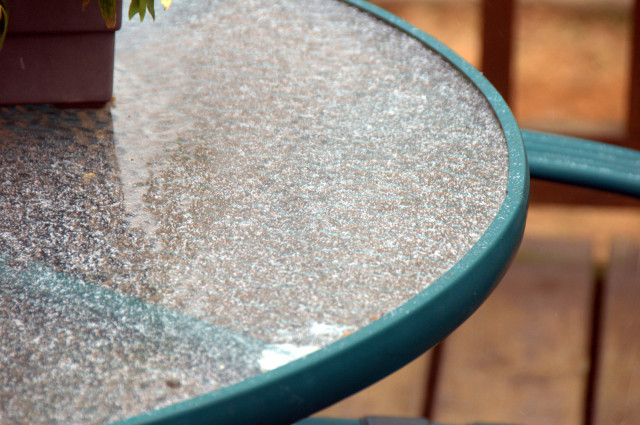
Today in school, after the first two periods, when eighth grade students were heading off to their various third period related arts classes, the teachers spoke in a hush.
“Mr. M said we’re going to be releasing at twelve today.”
But it was all in anticipation of the storm bearing down on the South. It wasn’t the first time I’d experienced an in-expectation snow day: several years ago, when we lived in Asheville, schools closed the day Babcia was supposed to arrive, also in expectation of a mother-of-all storms. That one never materialized, though. So today I was a little skeptical of the whole prognosis as we got the kids through lunch and hustled out to their buses. I arrived at home around two, and nothing.
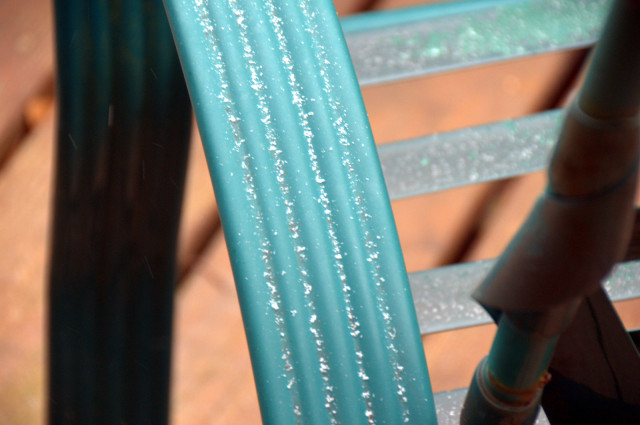
Finally the snow started falling, but the flakes were so small that they were difficult to see, and after fifteen minutes, only the lightest of dusting covered the table and chairs on the deck.
“Can we go outside?” L asked, eager to play in the snow and checking the window periodically.
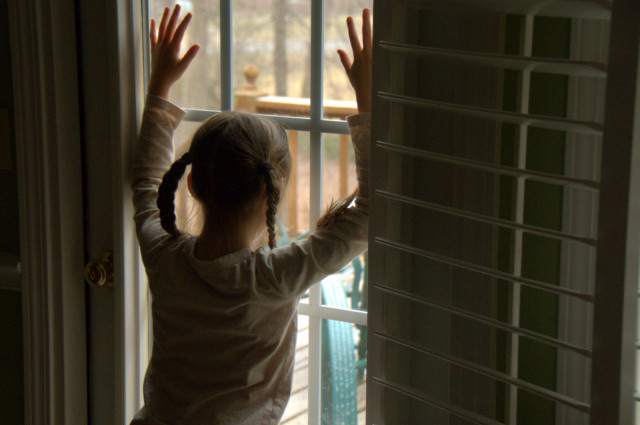
“Can we have a snowball fight? Can we build a snowman?” L has had so little experience with snow that she can’t understand the amount of snow a simple snowball needs. She has no idea the difference between wet snow and dry snow and the impossibility of making snowballs and snowpeople from the latter.
The Boy, having been in Poland last January, has much more experience with snow. The only problem is, he doesn’t remember it. So he too was fascinated with the white powder on our back deck.
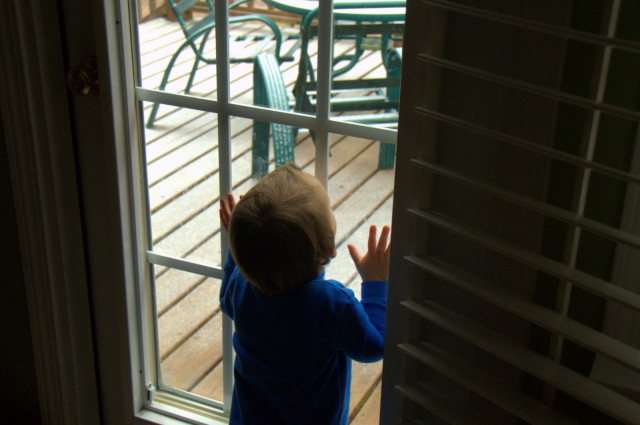
L and the Boy returned to their cartoons, and finally the snow became significant, hiding the glass under its less-slight dusting and making significant inroads with the chairs.
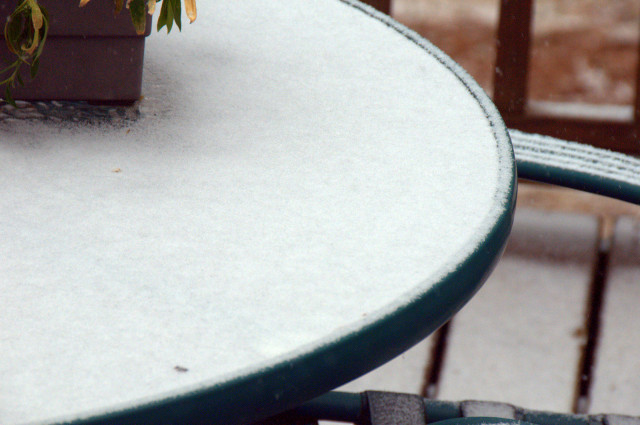
Close, but not enough.

Finally, the Girl could stand it no longer. “Daddy, I’m going out!” And off she went, searching for snow to eat and a patch large enough to ball into a projectile.
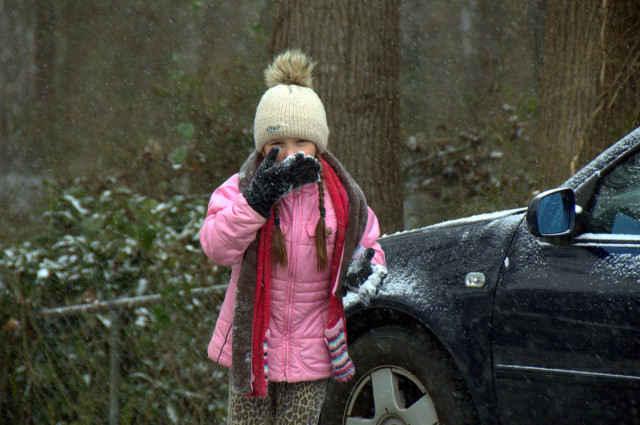
I got the Boy and headed out shortly after. After marching about the yard for a while, he began scooping swirls of snow, leaves, and dirt in the backyard.
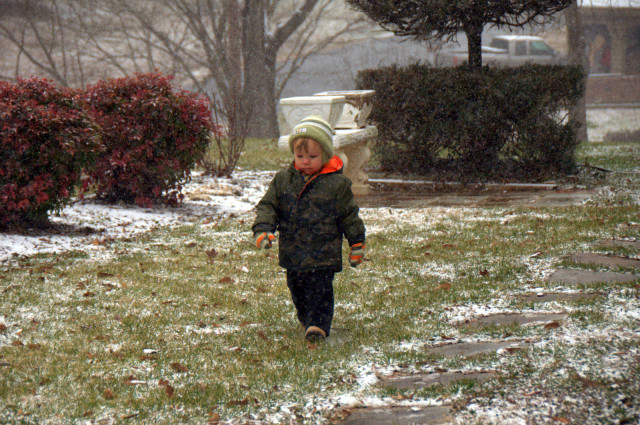
L on the other hand was working on a collection of snow in the cat’s outside bowl.
Once K arrived and we’d stuffed ourselves with chili (what else to eat in such weather?), the four of us handed out for a family walk. The sun had set but the night was still bright with the sparse snow and gray sky reflecting street lights, and the stroller’s wheels crunched in the snow: surely everyone who saw us thought us mad. Our stroll took us to the edge of our neighborhood, into a parking lot of a small corporate office. The Boy was convinced it was “babbas,” a gigantic manifestation of the bubbles in his bath that have become a highlight of his day. He ran in the snow, occasionally calling “babbas!” The Girl chased him, chased K, chased me, obsessively calling, “You’re it!”

So much joy from just a dusting of snow. Only finding out we could do it all again tomorrow made it better.
In the mid-80’s, when I was a young teen, my uncle’s doctors discovered that he had highly advanced kidney cancer — so advanced that they said there was nothing they could do. Six weeks or so later, I was a pallbearer at his funeral. It was quite a shock for the family, for he was just in his early fifties, and it all happened so quickly.
Yet, looking back and considering the number of cigarettes he smoked daily and the number of years he continued the habit, it’s not entirely unexpected. Actions have consequences; those consequences in turn often lead to still other repercussions.
One of these was the almost-continual driving back and forth from our home in Virginia to the hospital in South Carolina that was treating my uncle. It was summer; I was out of school and my father was taking time off work, so the three of us went back and forth, spending the weekends and other occasional days sitting in the waititng room or by my father’s brother’s bedside. I spent a good bit of my time reading Stephen King, skateboarding in the parking lot, and walking to the Hardee’s down the street for something sweet to drink.
I didn’t like hanging out in my uncle’s room, mainly for selfish reasons. It was stressful walking down the hall, seeing all the aged and decrepit (little did I know) patients, their rooms open, their eyes following every visitor as we walked by their doors. Additionally, the odors were, to my immature nose, offensive and probably unnecessary. So little did I know of death and dying; so little do I know now, but at least I understand its natural elements a little better.
In some ways what bothered me most was seeing my father helpless. It was obvious in his voice and countenance that this was one of the most trying experiences of his life. He was constantly asking his brother if he need anything: another pillow, the television on, the blinds closed, the television off, the blinds open. He sat sometimes and wiped his brother’s forehead with a cool cloth and, as far as I recall, said nothing. What could he say?
You’re supposed to pull unreservedly for your home team. It’s a form of loyalty, perhaps. But sometimes, it’s just hard. Sometimes, you’re glad for every single point the opposition scores. When a game starts with an enormous lead, and all the breaks seem to be going to the home team, and the visitors just seem completely outclassed, it only seems the sensible thing to pull for the visitors.
When the coach pulls out the starters (mostly eighth graders) and allows players from lower grades to play and the lead only grows, the game becomes almost painful to watch, especially when the visitors make so many unforced errors, to mix sports terminology. The frustration on their faces, the despondency on the bench. It hurts just to watch.
Or does it? As the point difference climbs, the visiting team seems to be more heroic. They don’t give up. They don’t slow their pace. They continue fighting even though it’s clear to everyone in the gymnasium that they’re outgunned.
When I was a coach, my one season as a volleyball coach, we faced game after game like this. I admired the girls for going out every time and giving it their best, and I told them as much. “What you did requires more character than the other team exhibited by winning,” I said. For middle schoolers, though, character isn’t all it’s cracked up to be.
As I walked out of the gym tonight with most of the final quarter remaining, I glanced back up at the scoreboard and saw how dismal things had become. Part of me wanted to stick around and tell the visitors what courage they’d shown; part of me thought that might be taken as some sort of gloating. In the end, I left hoping their coach had the sense to say those words.
I heard the crying first thing in the morning. L was nearly panicked, her crying almost a heaving, desperate bawling.
“What’s wrong, sweetie?”
“The tooth fairy! She didn’t come!”
Uh oh.
The tooth came out unexpectedly last night. She came running to me, showing the new gap in her lower teeth, explaining that she’d just bitten into an apple and boom — out it came. The first disaster of the experience occurred shortly after that, for we couldn’t find the little circular plastic container that the dentist had given her for her lost teeth. We searched and searched, but no one could remember where we’d put it after the last lost tooth.
I suggested that she put it on a bookshelf. “The tooth fairy will be able to hone in on it then,” I explained, thinking, “and that might make it a little easier for me to remember.”
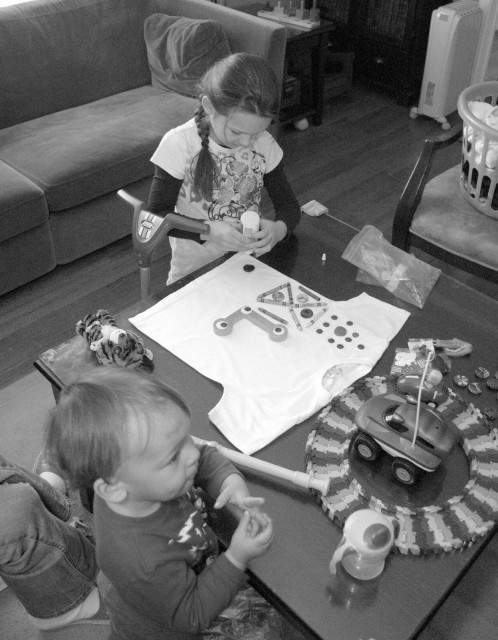
In the end, she put it in a plastic bag, which she tucked under her pillow.
“Well,” I said this morning, “perhaps the plastic bag somehow messed things up.” I could almost sense the gears turning, could almost hear the response: “But Daddy, that can’t be it. The last time, I put it in the little box the dentist gave me, and that was plastic!” So I made a preemptive explanation: “That’s odd, because the fairy box the dentist gave you is plastic. Perhaps it’s the type of plastic, or the fact that it’s in a bag.”
What a good thing that I didn’t almost blow it with the tooth fairy like I almost did with Santa, when I called down to K, “When did we buy that telescope?”
“Wait, did you buy it or did Santa?” L had asked.
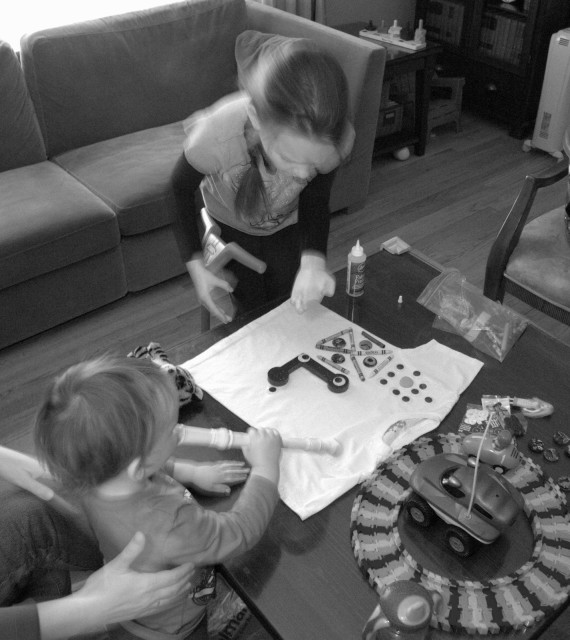
So it could have been much worse. A forgotten tooth fairy night can be remedied with the explanation that even the tooth fairy needs a night off and a couple of bucks under her pillow the next night. But there’s the question of whether one wants to do this: isn’t it essentially lying to your child? I always thought that as a teen and young adult, when the thought of being a parent first flitted into by brain. Now, with a bit more experience, I see it differently: it’s no more lying than telling a story is lying. We don’t take the time to examine the veracity of each story we read to the Girl. We don’t cultivate a sense of doubt in her simply for the sake of creating a skeptical daughter. We do it because a sense of the mysterious is not such a bad thing.
Yet as I left her room this evening, I realized that she could have peeked through one eye to see me sneaking out and I’d never know it. Maybe she’ll let us believe we’re still fooling her.
“Do your parents still believe you believe in the tooth fairy and all that?” a friend might ask.
“Yeah, it makes them feel good,” she might respond. “It lets them think I’m still a little girl.”
In a way, as long as she believes in the tooth fairy, as long as a missed visit causes tears, she is. But on the other hand, she put it behind her easily enough and soon was making her “100th Day of School” shirt, gluing anything and everything she could think of to her t-shirt. Had such a disaster occurred just a few months ago, I can’t see her getting over it so quickly. Just more proof that L’s imagined conversation contains the unavoidable truth: she won’t be a little girl forever, nor would we want her to be.
Few things are as rewarding as getting one’s guitar and playing in a darkened hushed room until one’s son is fast asleep.
Among all the metrics we use to measure kids’ performance, the most useful in many ways is the MAP test. We give it at the beginning of the year and again at the end, and in past years, we’ve set personal performance goals using it as a standard. Average yearly growth for an eighth grader reading at grade level is about three points. Great growth is around seven or eight points. For those a little below eighth grade level, good growth is around six or eight points.
This year, I’ve conducted an experiment, pairing daily during silent sustained reading students who excel at reading with those who excel at other academic ventures. The idea was simple: the strong readers would help the weaker readers by explaining what and how they inferred things in the article, working together to figure out word meanings in the article strictly from context clues, discussing the contents of the article, and a number of other tricks and practices. We’ve been doing that most of the semester. Recently, the students took a shortened version of the MAP test and the results merited a Klondike ice cream party: average growth for one semester was 7.4 points, with two students increasing by an astonishing 15 points and one student by 14 points.
It was a good day to be a teacher.
Dear Terrence,
To see your excitement when you got your report card this afternoon was one of those moments that makes all the silliness I have to put up with as a teacher worth it. You’re the type of kid who is simply used to having an F or two on your report card. The question for you, I think, has always been how many. And so when I told you “Not a single F” as I handed the report card to you, I would have loved to capture your expression. We could use it as a visual illustration of “pride.”
Next goal: honor roll.
Smiling with you,
Your Teacher
Every day, I teach kids how to write better. I teach them how to organize their thoughts, how to plan their writing, how to improve their sentence variety, how to proofread effectively, and seemingly countless other things. As L has begun school, I’ve been thinking about what it will be like to teach L these things, at which age I might begin, how quickly we might progress. How fun it might be.
Last night, it began.
“I have a report to write for school. We had to choose an animal we don’t know anything about. I chose a sea turtle,” she said last night. And so we went off to the library to get some books on the subject. She devoured two of them during her evening reading ritual and was ready to go.
“Tomorrow,” I assured her.
Tonight, after dinner, we sat down at the computer and I began teaching the Girl how to make an outline. For practice, we worked on favorites: favorite animals, favorite foods, favorite books.
Then the first outline of the report itself. Some from her head; some from her books. It was slow going: we had to figure out how to spell words, how to type those words (“Where is ‘z’ daddy?”). And the end result?
When you’re with two full-blooded Poles and two half-blooded Poles and you’re near a fort named after a Pole, there’s only one thing to do: visit said fort.
Named for the Polish hero of the American Revolution, Kazimierz Michał Wacław Wiktor Pułaski, the fort named for him represented a turning point in the history of fortifications: it was the first real bombardment of a fort with rifled cannon fire, and compared to the traditional smooth-bore cannon, the new rifled cannon and bullet-shaped shot proved highly effective. The outer wall was breached with cannon fire from positions over a mile away, and the damaged area is still visible due to the different shade of bricks Union soldiers used in repairing the damage.
And still shells remain lodged in the wall.
Of course, none of this was of any interest to either the Boy or the Girl. They were happy just to run about the parade ground, climb on cannons, and investigate large mysterious openings in the fortifications.
We took a walk about the fort, heading out to the Cockspur Island Lighthouse, which has not been in use for over a hundred years — a little bit of history sitting on an oyster- and mussel-shell bed.
Along the way, we saw why: with the river dredged for such huge container ships, a small lighthouse would be a joke today, and as the dredging began before the turn of the century, the lighthouses’ useful days were certainly finite.
Still, none of this was of any interest to the kids. What was of interest, and what we regretted putting off until the very end, was the beach. Cold, windy, yet still irresistible.
A playground next to a cemetery with Revolutionary War era monuments, the monuments worn illegible by centuries of rain and wind, surrounded by live oaks, the playground itself surrounded by magnolias and littered with Spanish Moss, with church bells ringing in the distance — it all seems prototypically southern. E and I spent an hour in such a playground this morning while everyone else was in Mass: the Boy just didn’t want to cooperate, and the lack of a viable way to isolate his fussing (i.e., a crying room) left me with few alternatives. We walked out of the church and within moments found ourselves at a playground beside Colonial Park Cemetery. E climbed and swinged, jumped and slid, and then we went for a short walk along the oyster-shell paved walk of the cemetery.
An ironically unplanned place for E and me to start our second day in Savannah for a number of reasons, not the least of which was the fact that our first site to see was Bonaventure Cemetery, the largest graveyard in the area and likely one of the largest in the south, famous from its staring role in Midnight in the Garden of Good and Evil. The plan was simple: the Boy could sleep, and indeed he drifted off as we drove there, and we would have a chance for a pleasant walk in a lovely cemetery.
Cemeteries always hold surprises, and Bonaventure didn’t disappoint in that regard given the number of Jewish graves with Jewish and even Cyrillic inscriptions. L and I walked about with Babcia, commenting on the typically Jewish surnames we were discovering (Singer, Rosenberg, Goldstein, Cohn) and the tragic-comic nature of so much Jewish literature.
The sunlight filtering through the Spanish Moss hanging on the countless Live Oaks cast a soft hue on everything and made it a perfect place to sit and perhaps read a book or chat about things of real importance, but we had a schedule and, once he woke, a hungry boy, so after Babcia and K triangulated and positioned themselves (it was imperative that Babcia call and ask her now-famous question, “Gdzie jestescie?”), we headed to the historic district for lunch and a walk.
The former was a disaster at the over-price, over-rated Shrimp Factory that seemed to have irony on the menu (my jambalaya had microscopic shrimp that were few and far between) and slow service as the soup of the day. The latter was what could be expected in the most charming little city in the South. A riverside walk, wandering through streetside cafes (why didn’t we eat in one of them?) with various buskers and plastic sculptures (what an odd combination, but there they were, opposite each other), and ice cream shops open in mid-January all soon put us in better spirits. What’s not to love about Savannah, after all? It’s the perfect tourist destination: small, wrapped in history, dotted with countless squares — and high real estate with no jobs for anyone, Babcia and K would add. Perhaps that’s how the locals keep the average tourist from thinking the inevitable: what if we could move here?
As the sun cast increasingly longer shadows and the chill returned to the air, we realized we were back near the church where we’d begun our day. K and Babcia took the kids to the playground where E and I started the day and I headed back to the Cathedral of St. John the Baptist, a church that actually looks, sounds, and feels like a church, with mult-level vaulted ceilings, sculptures of saints, stained glass, an enormous organ, and an echo.
I headed back to the others, played with the kids a bit, and returned to the cemetery, this time with a camera, the sun once again filtering through the Spanish Moss but this time from the opposite direction.
Dear Hotel Management:
When you said you have free Wi-fi, I took you at your word and assumed that by “Wi-fi” you meant a wireless internet connection with speeds comparable for, say, 2008. I mean, it is a hotel and the internet connection is free: I wasn’t really expecting blistering speed. On the other hand, I also wasn’t really expecting a throw-back to the early 1990’s when dial-up bulletin board sites were the precursor to the internet and sometimes had speeds as low as 300 baud. In half an hour, I couldn’t even upload a single picture.
Talk about first-world problems…
Regards,
Your Customer
The first album I ever bought is one I’m almost loathe to admit to now. The second, less so: Boston’s Third Stage. I was in seventh or eighth grade when I bought those albums, and it was no small feat, for my father had made a rule that he had to investigate and approve any music purchase I made. At the time, I thought it was ridiculous. As a father myself, now I understand.
Recently, L made a discovery: portable music is highly convenient. She’s been taking my iPod about, listening to whatever she finds on there that strikes her fancy. That’s almost fine: most of my music I’d willingly play for her, but there is this and that which I don’t think she’s quite ready for. Fortunately, she was more drawn to jazz than anything else. Ben Webster’s “Late Date” was a particular favorite.
Still, there’s always the risk of accidental discovery of something she’s not quite ready for. So when L suggested she buy her own MP3 player with the money she’s saved up, it seemed a good idea.
It came Wednesday, and I loaded it up with Ben Webster, Sonny Stitts, Buena Vista Social Club, Beatles, and similar selections, and K bought her the Frozen soundtrack as a first album.
And yet, as I sit here listening to the newest John Mayer on Spotify, I realize that by the time she’ll be the age I was when I first bought my first album, iPods will even seem old-school. All music available all the time.
What will she listen to?
I’m not so much worried about what she’ll listen to as I am the music her potential suitors will be drawn to. A boy who listens to misogynistic rap will likely be somewhat affected by it — at the very least, his disregard for what the man is actually saying will be worrying. Of course with the prevalence of free online porn, what the young man might be listening to might be of less concern than what he’s streaming on his phone.
All of this flashed in my thoughts as I saw L dancing about, singing along as best she could to a song she barely knows, and I thought that perhaps Babcia is right: the nineteenth century was so much better…
E is entering the wide world of language, three languages at a time. He grunts and coos sometimes, but he’s started using a few words, both Polish and English. For example, he has a “Yes” grunt and a “No” grunt, but he also says “Yes” and “No.” Sort of. When I have difficulty discerning whether his grunt is affirmative, I ask him, “Yes or no?”
“Tak” comes the reply.